I had a great Halloween blog prepared, but I managed to delete it when I was making room on my laptop. I haven't time to redo it, as I am preparing for my daughter's birthday Halloween party - a big deal for us Australians, let me tell you! So instead, here is are a few vintage Halloween postcard images (some of which are available to buy, just click the links)
Wednesday 31 October 2012
Tuesday 30 October 2012
Quadracycles
A little journey from military fashion to more bicycles.
Here is unusual attire for the army, bowler hat and lounge
suit! The photo is actually of inventor
F.R. Simms demonstrating his Simms Motor Scout Armoured Quadricycle in 1899. He constructed the vehicle by mounting a Maxim machine
gun on the front wheels bar of a French De Dion-Bouton Quadracycle,
and adding an iron shield in front of the vehicle for the driver/gunner's
protection.
Quadracycles were popular with fire and postal services.
there is a beautiful example of a fireman's quadracycle at he Brisbane Museum, which actually seats four, and has an attached trailer for the hose.
And Henry Fords first car in 1896.
Here's a close up of the engine. Isn't it beautiful?!
And the Quadracycle in all it's glory.
I can't imagine how expensive one would be to buy now, but here is a replica someone in Indiana made. it sold for a mere $5,000!
Lovely, don't you think?
A quadcycle is basically a bicycle with four wheels, one at
each corner, ridden by one or, more often, more people. They were invented around the same time as two-wheeled
bicycles , and the earliest recorded pedal-powered quadracycle was exhibited in
1853 at the Exhibition of the Industry of All Nations World's Fair held
in New York City.
Side by side Quadracycles were more stable at low speeds
than bicycles and in-line tandems and it was harder to fall off. Early
designs used foot levers, but in 1885 the Coventry Rotary Quadracycle was
introduced which used conventional bicycle-style rotary pedals instead. It was
developed from a similar tricycle design and featured tandem seating for two.
 |
| Smartly dressed couple seated on an 1886-model quadracycle for two. The South Portico of the White House, Washington, D.C., in the background.c 1886 |
In 1888 The Rudge Quadracycle was designed, and it
is described as the first modern
practical four-wheeler. It had much lighter construction than earlier models,
seated three riders in tandem and was steered by levers from the front seat.
 |
| c. 1888 |
 |
| c. 1890 |
The Quadracycle of course quickly morphed into a horseless carriage, such as this one.
 |
| 1894 Balzar |
 |
| c.1896 |
 |
| Ford Quadracycle engine |
 |
| Ford Quadracycle |
 |
| Ford Quadracycle replica source |
Deb xx
Labels:
1800s,
1890s,
1896,
Armoured,
Ford,
Military,
Quadracycle,
Quadricycle,
Victorian
Monday 29 October 2012
Victorian Military Bicycle Uniforms
With
bicycles so popular in the late 19th century, in Europe, the United States and
Australia, it was inevitable the military would find a use for them. Bicycles
were easier to care for than horses, required no fuel or food, a small storage
space and little maintenance. They were quiet, and riders could be easily
trained. Soldiers previously on foot could travel faster and carry more with a
cycle. Bicycle units were formed at the end of the 19th century by all European armies
and the US armed forces, and to some extent took over from the mounted
infantry.
 |
| Cycle company at Bury St Edmonds, Suffolk |
Folding
bicycles were developed from about 1895 by Morel and Geraud, and the French
army tested about 25 of these bikes. The patent for the folding bike was sold to a
consortium of Peugeot, Michelin, and the French army and they took over
production of the bike in 1899.
In 1896 in the United
States, an extensive experimentation on bicycle units was carried out by a 1st
Lieutenant Moss, of the Twenty-fifth United States Infantry Regiment (one of
the racially segregated units of the United States Army known as Buffalo
Soldiers). The 25th Infantry U.S. Army Bicycle Corps set out across the country
on bicycles from Fort Missoula, Montana to several different locations with their
greatest trip covering 1,900 miles to St. Louis, Missouri, returning to
Missoula by train. Here they are at Minerva Terrace, Yellowstone National
Park, 1897.
 |
| Photos by Frank Jay Haynes Source |
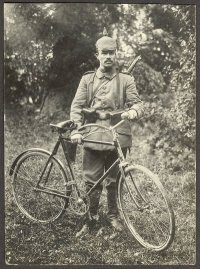 |
| Soldier during the 2nd Boer War source |
 |
| Soldiers with early folding cycles |
Three years later in the Second
Boer War, military cyclists were used primarily as scouts and
messengers, although several raids were conducted by cycle-mounted infantry on
both sides.
 |
| Simon Dussault folding bicycle c. 1895 |
One unit patrolled railroad
lines on specially constructed tandem bicycles that were fixed to the
rails. Mikael Pedersen had developed a two-rider tandem version of his Pedersen bicycle in about 1898 that weighed 24 pounds, and a four-rider, or
"quad", that weighed 64 pounds, and earlier in 1895 Julien Simon and Victor Dussault, both of
Paris, France, patented a folding tandem
bicycle which they described a regular folding bike that could be converted
into a folding tandem with the addition of another frame and connecting parts.
Other early folding bikes were the Faun Folding Cycle
produced in England in 1896 and the Dwyer Folding Bicycle made in Connecticut ,
designed by Michael B. Ryan, which was sold to the military as well as the
public. This photo is from an article
about the Dwyer folding bicycle in the Scientific American magazine dated March
13, 1897 showing a soldier demonstrating the folding operation of the bike.
The uniforms for cyclist soldiers tended to have loose pants and gaiters, no matter which army they were fighting for. Very similar to this Sardinian uniform from 1859, which I had to include because I just love it!
Deb xx
Saturday 27 October 2012
Victorian Nostaglia & Steampunk
I have come to a realisation.
I love Steampunk.
What is "Steampunk?" you may ask.
Basically Steampunk is Victorian science-fiction-fantasy, or the past that never was. Old done in a new way or vice-versa - Victorian outfits with a modern twist, or mobile phones made of leather and brass. Steampunk takes it's name from the time of Steam power, and the punk genre of being different and questioning everything. Why do we have to have boring clothes made in China or plastic everything and sameness? Why can't we have beauty and fun, traditional materials like leather, timber, brass and copper, items that can be tinkered with and not just thrown away when broken or uncool. With Steampunk, you have the best things of the Victorian era, without the hardships, racism, sexism and child labour. It's Victorian nostalgia in a way - looking at the past through rose coloured glasses.
.
If you love vintage, you're part steampunk already. I have been Seampunk for years and just never knew it had a name. My first house (twenty years ago now) was built in 1910, with high ceilings and lots of timber and we renovated it with brass light fittings and fans, and had brown velvet sofas and Persian rugs. I so miss it, but hoped in Queensland I would have an old timber Queenslander - I am still waiting. One day I may have something like this!
Probably not, but while I am waiting I shall continue to research the Victorian and Edwardian eras, and Steampunk. As well as this blog I have started a tumblr page, which explores Steampunk in all it's forms, with photos and quotes. It's called Brass Butterflies and the link is in the side bar.
As well as being a little bit 'Steamy' in my daily life, I am working on some costume ideas for a Steamfest next August in Ipswich, Queensland, so I'll jot about then too. Any input is welcome! And if you are in Queensland next August, think about attending.........
Go to the website for more information.
Farewell for now, tumblr awaits.
Deb xx
I love Steampunk.
What is "Steampunk?" you may ask.
Basically Steampunk is Victorian science-fiction-fantasy, or the past that never was. Old done in a new way or vice-versa - Victorian outfits with a modern twist, or mobile phones made of leather and brass. Steampunk takes it's name from the time of Steam power, and the punk genre of being different and questioning everything. Why do we have to have boring clothes made in China or plastic everything and sameness? Why can't we have beauty and fun, traditional materials like leather, timber, brass and copper, items that can be tinkered with and not just thrown away when broken or uncool. With Steampunk, you have the best things of the Victorian era, without the hardships, racism, sexism and child labour. It's Victorian nostalgia in a way - looking at the past through rose coloured glasses.
.
 |
| Put these on baby! |
If you love vintage, you're part steampunk already. I have been Seampunk for years and just never knew it had a name. My first house (twenty years ago now) was built in 1910, with high ceilings and lots of timber and we renovated it with brass light fittings and fans, and had brown velvet sofas and Persian rugs. I so miss it, but hoped in Queensland I would have an old timber Queenslander - I am still waiting. One day I may have something like this!
 |
| Brooklyn House, Fraser Coast QLDc. 1890 source |
As well as being a little bit 'Steamy' in my daily life, I am working on some costume ideas for a Steamfest next August in Ipswich, Queensland, so I'll jot about then too. Any input is welcome! And if you are in Queensland next August, think about attending.........
Go to the website for more information.
Farewell for now, tumblr awaits.
Deb xx
Thursday 25 October 2012
The Air Ship - a musical farce comedy from 1898
Distracted again, this time by these delightful posters
for The Air Ship, a musical comedy by JM Gaites from 1898.
 |
| source |
 |
| source |
Below is part of an article which appeared in the January
18, 1899 Fort Wayne News (Fort Wayne, Indiana):
"The Air Ship," a new and original
spectacular musical farce comedy, written by J.M. Gaites, possesses some novel
and realistic scenic features, and it will probably draw a big audience at the
Masonic Temple ton-night. One of the most realistic stage scenes ever
presented will be the flight of a real air ship with fifteen passengers on a
Klondike expedition, and a view of Dawson City in winter. While the author does
not claim a plot, "The Air Ship" has a central idea or theme, with
which it is infested by amusing dialogue, new songs, dances and specialties.
Careful attention will be given to staging "The Air Ship," and the
company of artists engaged will give a lively presentation of the farce.
I haven't been able to find out much about Mr Gaites,
but the posters are divine don't you think?
Deb xx
Wednesday 24 October 2012
1890s Cycling Fashions for Men
It is often remarked that men's fashions haven't changed
much over the years. Compared to women's fashions they didn't, but
each decade did have it's own specialities, such as breeches or
lace and embroidery on waistcoats. In looking at cycling fashions for men, I want to start with a little background at the everyday fashions for men of the 1890's.
The military
greatly influence men's (and women) clothing, both in style and
colour (red jackets from the late 1700's and khaki in the tropics).
During the 1890's there were still of course wars going on, but the
fashion also looked towards the cycling craze of the time, and the overall
silhouette of the 1890's was long, lean, and athletic.
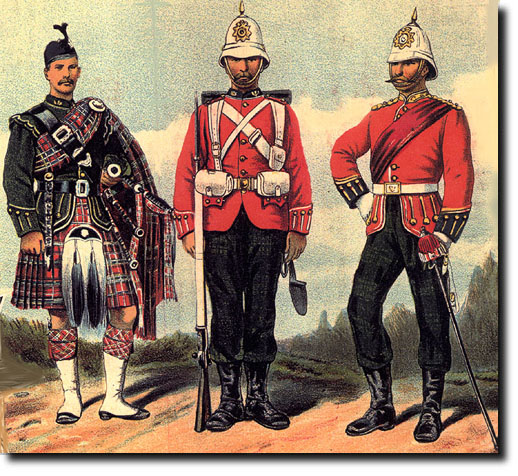 |
| British army piper, private and office c 1890 source |
When we think of Victorian fashions for men, apart from military uniforms, we often think of the formal and evening wear - tails and top hats. Dinner jackets or tuxedo's were worn in the evening, and tails only for formal evening events, and of course special race days, with a top hat. White shirts were worn with both, with black or bow ties, although they were again popular as day time accessories during the 90's. The Ascot tie was also worn, usually as a day accessory, made up as a neckband with wide wings attached and worn with a stick-pin, and a bowler hat and other soft felt hats or caps were worn during the day.
  |
The Hon. Derek William George Keppel Elegantly dressed Vanity Fair Illustration
1895
and
Mr Victor Cavendish, MP for Derbyshire West, wearing top
hat. Vanity Fair Illustration 1895
|
Although frock coats and the cutaway morning
coat was still worn for formal day occasions in Europe and major
cities elsewhere, lounge (sack) jackets became popular for
day time wear. These were worn as a suit, either matching
three piece affairs with a single breasted jacket, waistcoat and
trousers, or with a contrasting waistcoat (vest). Fabric varied, and could be smooth and fine or rougher almost tweed.
 |
| Morning coat and lounge suits c. 1895. source |
 |
| Perhaps not a realistic cycling outfit of the time? |
 |
| White Flannel Pants, blazer & Boater - pants rolled up a little at least! |
The blazer was worn for casual activities such as sailing or
boating - cut in a similar style to the lounge coat, the fabric was
either navy blue or brightly-colored or striped, often in wool flannel, with
patch pockets and brass buttons. These were often worn with light coloured flannel pants, or even shorts, with a straw boater or a cap.
 |
| Cycling in a blazer and cap c.1892 source |
  |
| Mr
Rudolf Chambers Lehmann, rowing coach, In flannels and blazer and Mr Charles Pittman, rower, in white shorts and sweater. |
Tweed jackets (Norfolk jacket) were fashionable to
rugged outdoor and winter activities like hunting and shooting.
It featured paired box pleats over the chest and back for greater
arm movement, with a fabric belt. The matching trousers were
often replaced with matching breeches (knickerbockers) to make it suitable for suitable
for bicycling, and also golf, with knee-length stockings and low shoes, or for
hunting with sturdy boots or shoes with leather gaiters.
 |
| Sears Roebuck Catalogue 1897. source |
 |
| Tourists riding bicycles by A.B. Frost c.1896. |
 |
| Thomas E. Kent for Bicycle Clothing 1896 |
 |
| The poster from the first tweed run 2009 |
 |
| Caps & Breeches, cycling in Norway 1898 source |
 |
| Cycling c. 1895 source |
Many ordinary gents, or those riding to work where breeches would have not been worn, wore their day suits for cycling. Some would tuck in one leg of there pants into their socks, to avoid it getting caught by the chain, and others would wear bicycle clips. I can remember my father doing this.
 |
| Man and cycle, long trousers and felt cap, c.1895 source |
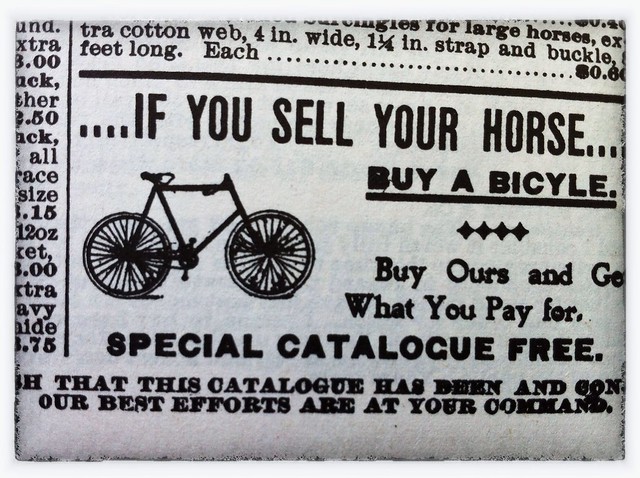 |
| Sear Roebuck Catalogue 1897 |
 |
| man and cycle, long trousers, vest and Stetson c 1890s source |
 |
| Cyclist c .1890s source |
 |
| French cyclists c 1895 source |
There was also specialist sporting clothing for athletes
such as swimmers, boxers and speed cyclists, but these were not generally worn by the ordinary man.
 |
| Cycling race, 1899 source |
 |
| c 1890 source |
 |
| French Olympic cyclists 1896 source |
Deb xx
Tuesday 23 October 2012
Bicycling 1890's Style for Ladies


Bicycling became almost a cult in the 1890s. The development of the pneumatic tyre and the mass production of machines meant that cycling was now comfortable and affordable, and as Queen Victoria Herself had purchased tricycles for her daughters (Starley's), it also became acceptable. As hundreds of young bicycle manufacturers competed for sales, prices dropped from over $100 to as low as $20 for a new cycle, making them in the reach of just about anyone.
 |
| True or not?! |
The Pope Manufacturing Company in Hartford, Connecticut had been making
bicycles since 1878, and at the height of the bicycle craze in the 1890's, Pope
was the city’s largest employer, with 4,000 workers producing 600 bicycles a
day. It is estimated that in 1897 between 1 1/2 and 2 million bicycles were manufactured n the US, and that by 1900 there were about 10 million bicycles in use (from a population of 75 million).
 |
Ladies Cycle Club of Hartford, 1890.
|
By 1896 the Raleigh Cycle Company in Nottingham, England was making 30,000 cycles a year in the largest factory in the world, and produced more cycles globally than any other company. I don't think this was considered normal bicycle riding attire, however!
 |
| 1896 ad source |
"Let me tell you what I think about bicycling. It has done more to emancipate women than anything else in this world. It gives her a feeling of self-reliance and independence the moment she takes her seat; and away she goes, the picture of untrammelled womanhood. I stand and rejoice every time I see a woman on a wheel . . ."
-- Suffragette Susan B. Anthony in a Feb 2, 1896 speech, quoted in the New York World
I love this ad from 1896 - finally a woman's word is taken seriously!
Some outfits kept the look of the longer dress or jacket, but hid bloomers underneath - much like the riding habits of the time. This one is French, circa 1895 (source). Stunning, don't you think?

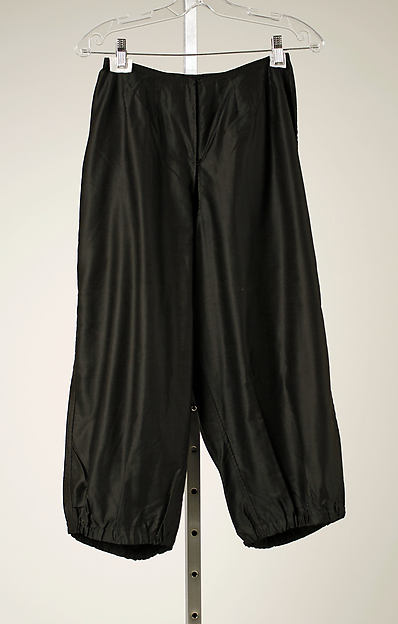

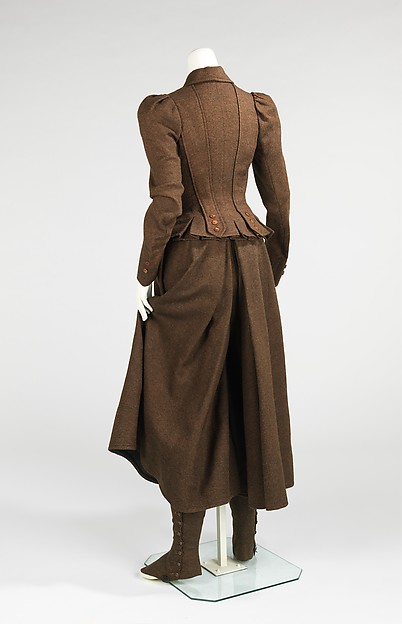
In warm climates, like Australia, a blouse was often worn instead of the jacket, and a sensible straw hat for protection from the sum.
Separate skirts and bloomer continued into the 1900's, such as this wool and linen American pairing (source).
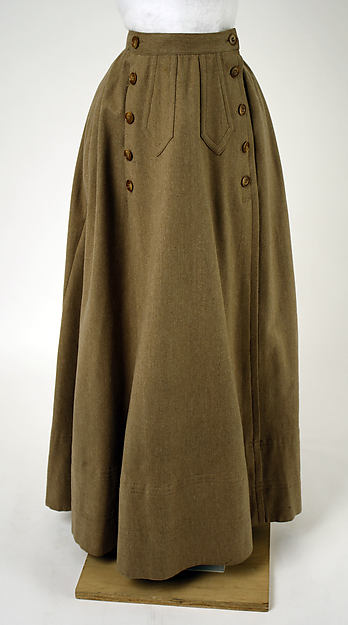

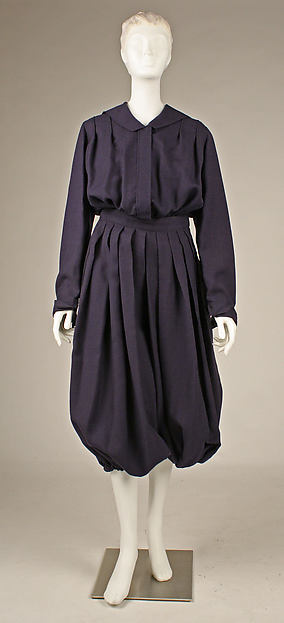
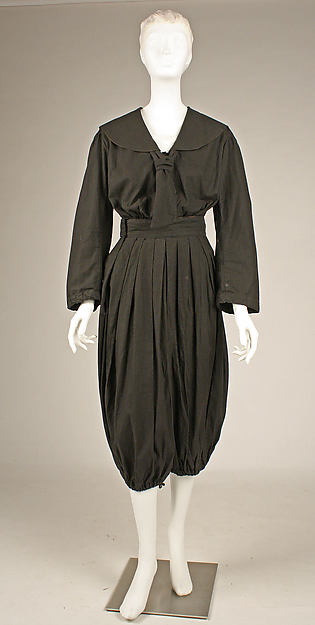

In addition to the cycling outfit, the well-dressed woman also wore leggings or gaiters, a hat, doeskin gloves and perhaps gauntlets, and a pair of the broad, low, rubber-soled cycling shoes which had first come on the marker in 1891. A bicycle belt, from which hung a small leather purse, completed the outfit.
You'll notice that many of the costumes are sombre colours, much like the riding habits that had been made by men's tailor's rather than seamstresses. Apparently the stylish women would dress to match her male companion, so grey, brown, dark green, or navy were the most popular colors.
 |
| Trust a woman for buying the right thing (finally, we are being taken seriously!) |
Although many women still wore their everyday dresses for
cycling, special outfits did develop, and the rational
dress movement gained momentum, helping liberate women from corsets
and ankle-length skirts. This Punch cartoon illustrates the point that many
women enjoyed the freedom of the new fashion.
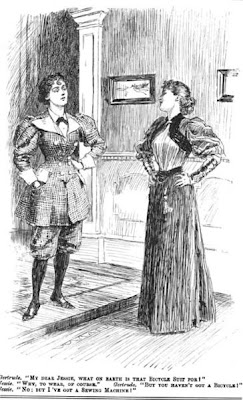 |
| My Dear Jennie, what on earth is that bicycle suit for. Why to wear of course. But you haven't got a bicycle. No, but I've got a sewing machine! |
Some outfits kept the look of the longer dress or jacket, but hid bloomers underneath - much like the riding habits of the time. This one is French, circa 1895 (source). Stunning, don't you think?


The other popular development in cycling fashion was the bifurcated
skirt in about 1892, that was like pants at the back with the modest appearance of a skirt at
front. This American suit of wool, linen, leather and silk also includes a pair of gaiters, which would provide
protection for the legs. (source)


Bloomers and knickerbockers
made bicycle riding even easier for women, but the style was still ridiculed by many as being
unfeminine and unattractive. These outfits are from about 1895. What do you think?
Oh, the bicycle girl, when she gets on the road, Is bound
neck or nothing to go!
Myself I love the calf length skirt, and I adore the hats! So much nicer than today's regulation helmets.
.jpg) |
| Catalogue. c. 1897 |
 |
| Lady cyclist, Brisbane, Australia c. 1895 |
 |
| An american version in linen - source |


Although bloomers did also remain popular, and began to be manufactured by reputable companies, such as this suit (below left) by A.G. Spalding and Bros. from 1902. It looks remarkably like the charcoal gym suit of a few years earlier by the Columbia Gymnasium Suit, Boston, Mass. (below centre source).



In addition to the cycling outfit, the well-dressed woman also wore leggings or gaiters, a hat, doeskin gloves and perhaps gauntlets, and a pair of the broad, low, rubber-soled cycling shoes which had first come on the marker in 1891. A bicycle belt, from which hung a small leather purse, completed the outfit.
 |
| cycling outfit c. 1895 source |
Those undertaking a bicycling expedition (defined as any trip over an hour in length) were also recommended to outfit their bicycle with a lamp, and to pack matches, tools, a repair kit, sewing materials, and first-aid supplies (and baby?!).
 |
| Cycling in Sn Francisco 1890s source |
What ever we may think about bloomers, cycling and bicycles really did change the face of fashion - and not just for women. Men's cycling fashions are next!
Deb xx
Subscribe to:
Posts (Atom)











